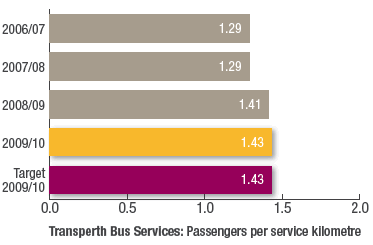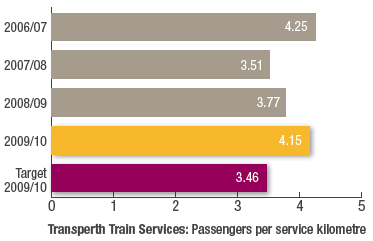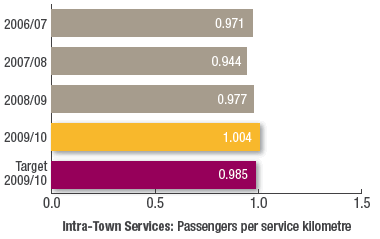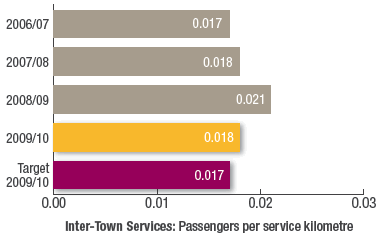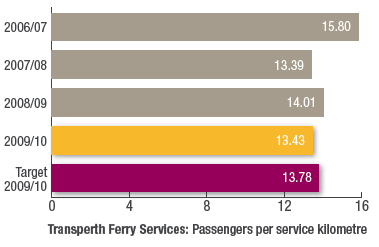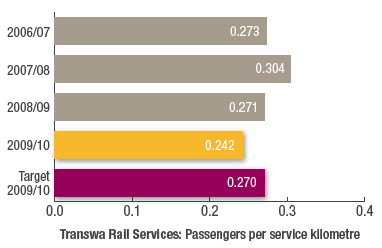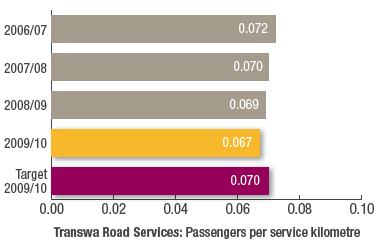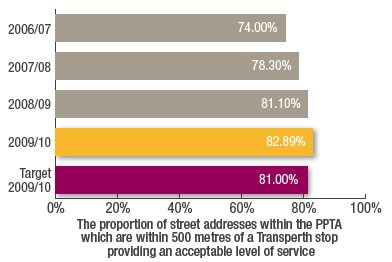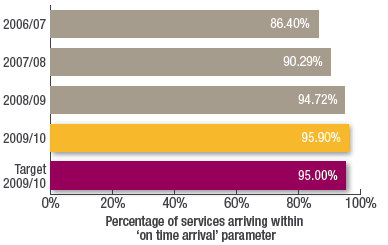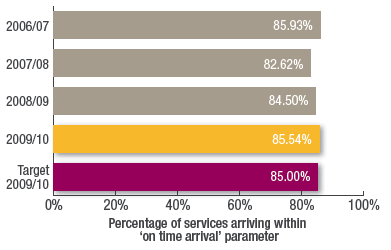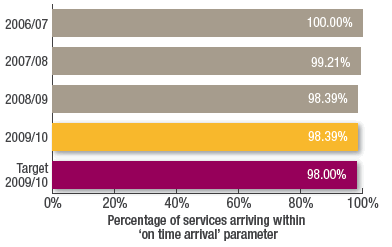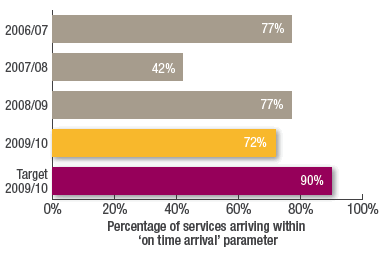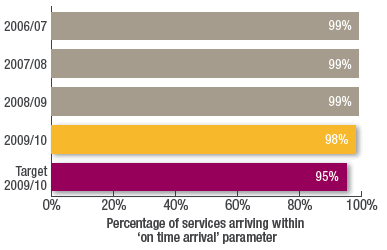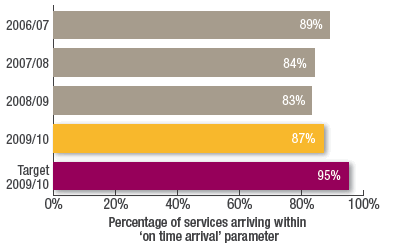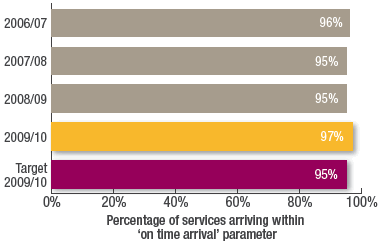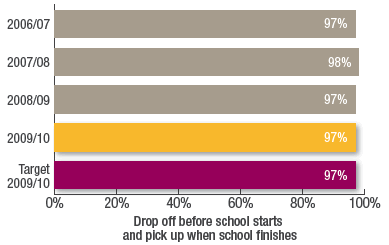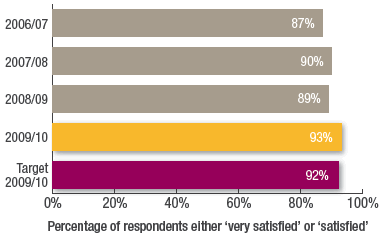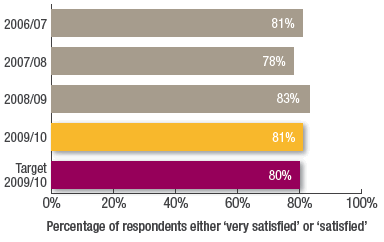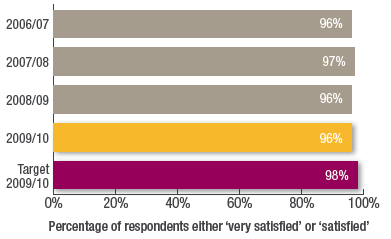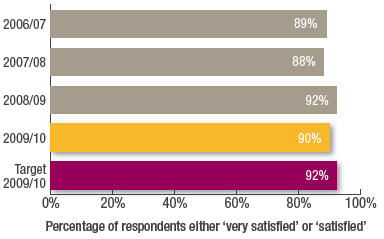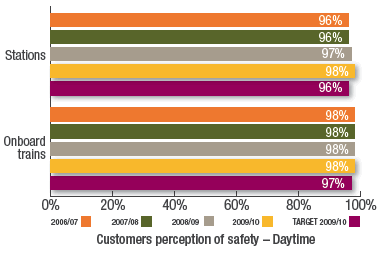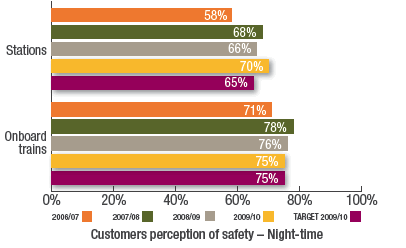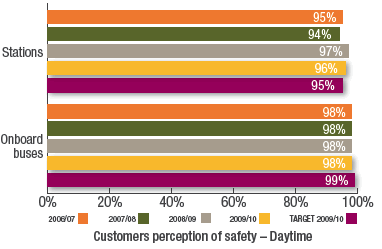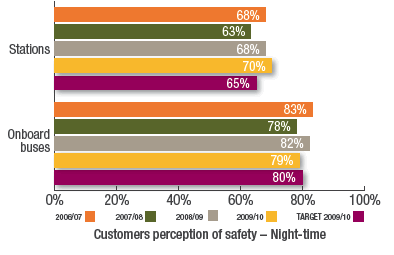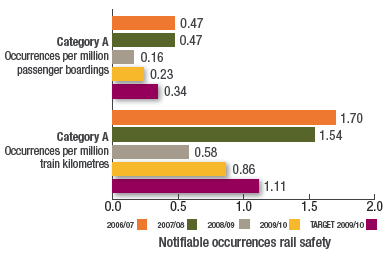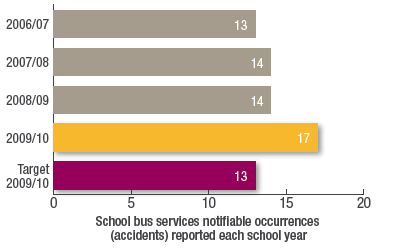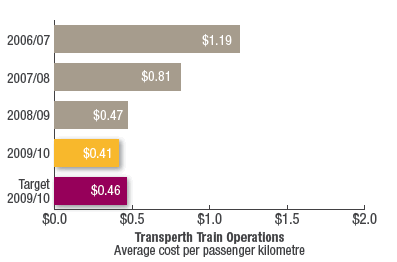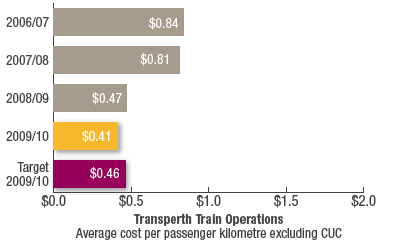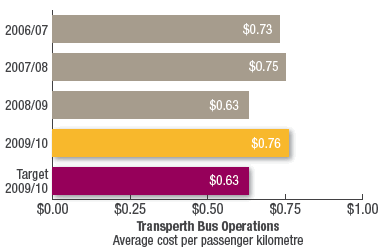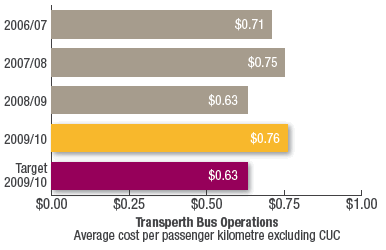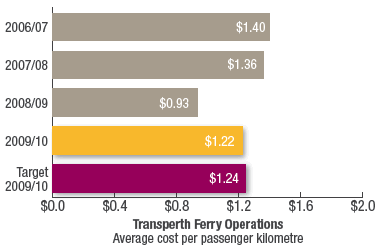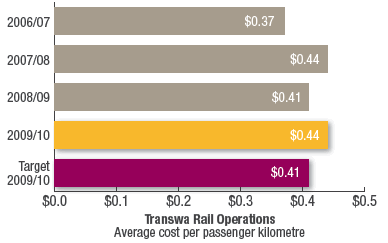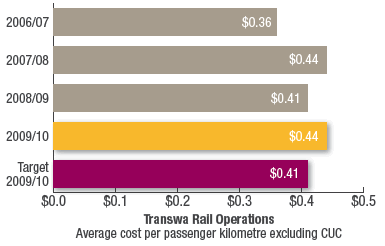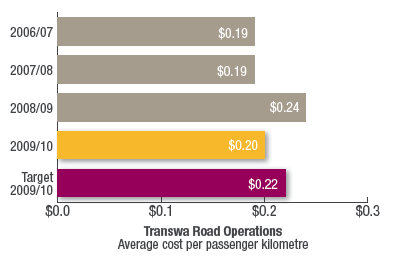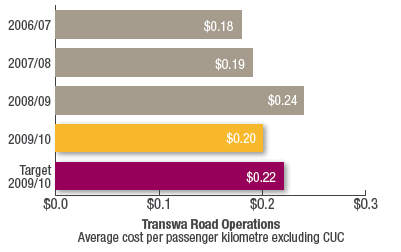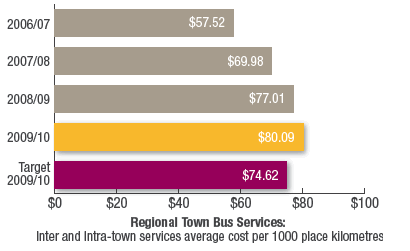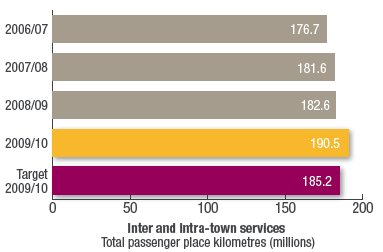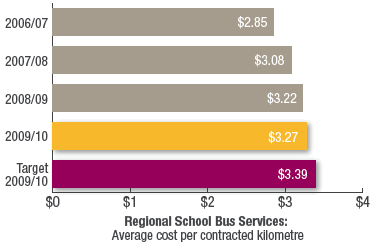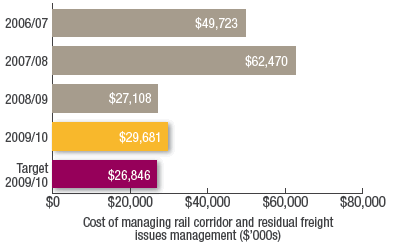Measuring Performance
Outcome 1: Accessible, reliable and safe public transport system
Effectiveness indicators
The PTA’s effectiveness in providing an accessible, reliable and safe public transport system is measured using the following key effectiveness indicators for:
- Use of public transport
- Accessible public transport
- Service reliability
- Level of overall customer satisfaction
- Customer perception of safety
- Level of notifiable safety incidents.
1. Use of Public Transport
The use of public transport is measured by comparing the annual number of passengers carried with the number of service kilometres. Service kilometres are kilometres operated on scheduled passenger services and exclude “non-productive running” i.e. travelling to or from the depot to commence a service trip or re-positioning to commence another service trip.
The measure indicates the extent to which services provided, as represented by the number of kilometres operated, are being utilised. An increasing trend in the indicator will generally signify that patronage is rising at a rate greater than the rate of increase in service kilometres operated and represents an improvement in effectiveness as well as an increase in the use of public transport.
This effectiveness indicator is applied to each mode of public transport. The indicator is based on total boardings on Transperth services and includes fare-paying boardings plus free travel and transfers. Transfers are boardings which occur either between services within the same mode or between modes during the specified ticket transfer time.
Transperth Bus Services
In 2009/10 boardings per service kilometre on bus services were on target and 0.97% above the previous year’s result. The target was based on projected annual total boardings of 74.419 million and 52.0 million service kilometres. Total boardings reached 74.756 million in 2009/10 compared to 73.550 million in 2008/09, an increase of 1.64% above 2008/09 and 0.45% above the target. Service kilometres also increased in 2009/10 by 0.66% to 52.340 million from 51.997 million in 2008/09 and exceeded the target by 0.65%.
Transperth Train Services
Boardings per service kilometre on train exceeded the target by 20.04% and the previous year’s result by 10.23%. The target was based on projected annual total boardings of 55.281 million boardings and 15.996 million service kilometres. During the year, total boardings increased by 3.03% to 56.409 million from 54.750 million in 2008/09 and were 2.04% above target. Service kilometres were 15.09% below target and 6.53% below the previous year. The reduction in service kilometres was due to the service revision introduced on 28 June 2009 which reduced annual service kilometres to 13.582 million from the target of 15.996 million kilometres.
Regional Town Bus Services
In order to provide a more meaningful result in reporting the performance of regional town bus services, the effectiveness indicator for passengers per service kilometre has been separated into intra-town and inter-town components.
Intra-town services operate within rural town boundaries, while inter-town services run between regional centres.
a. Intra-Town Services
The intra-town services in Bunbury, Port Hedland, Busselton, Carnarvon, Kalgoorlie, Broome, Collie, Kununurra, Manjimup and Narrogin performed strongly during 2009/10. Passengers per service kilometre for intra-town exceeded the target by 1.89% and the previous year’s result by 2.72%. During the year, total patronage increased by 4.73% to 2.466 million from 2.355 million in 2008/09. Service kilometres also increased to 2.457 million, 1.95% above the previous year’s result of 2.410 million.
b. Inter-Town Services
Passengers per service kilometre exceeded the target by 8.38% due to the improved performance of the Perth to Port Hedland and Kalgoorlie to Laverton road coach services but were 14.28% below the previous year due to the ending of the trial for the extended services between Point Sampson, Wickham, Roebourne, Karratha and Dampier. During the year, total patronage reduced by 21.20% to 6,368 from 8,081 in 2008/09. Service kilometres were 345,614, 8.07% below the previous year’s result of 375,952.
Transperth Ferry Services
The 2009/10 passengers per service kilometre were 2.54% below target and 4.12% below the previous year’s result. The target was based on projected annual total boardings of 476,000 and 34,500 service kilometres. In 2009/10, total boardings were 2.49% below target and 4.06% less than in 2008/09. Annual service kilometres at 34,559 were 0.07% more than in 2008/09 and exceeded the target by 0.17%.
Transwa Rail Services
Passengers per service kilometre in 2009/10 decreased by 10.52% against 2008/09 and were 10.23% lower than target. With the Australind resuming full service in May 2009, service kilometres increased by 9.38% to 996,279 kilometres from 2008/09. The increase in service kilometres and the further decline in patronage by 2.13% to 241,484 have contributed to the lower result.
Transwa Road Coach Services
The 2009/10 passengers per service kilometre was below target by 4.89% and 2008/09 by 3.38%. The lower result was due to a reduction of 5.50% in patronage to 214,538 and a reduction of 2.20% in service kilometres.
2. Accessible Public Transport
Accessibility to public transport, in terms of service coverage, is measured as the proportion of Property Street Addresses (PSA) within the Perth Public Transport Area (PPTA) which are within 500 metres of a Transperth stop providing an acceptable level of service. The PPTA defines the core operational areas for Transperth services.
“Acceptable service level” (ASL) is defined as an hourly service during the day with at least three trips per hour (i.e. at 20-minute intervals) in the peak flow direction in the morning and/or afternoon peaks, excluding dedicated school bus services.
The indicator uses PSA data from Landgate and service information and stop location data from the Transperth Route Information System (TRIS).
The measure demonstrates the extent to which the PTA meets its accessibility standards in the Perth metropolitan area.
The PSAs that were within walking distance (500 metres) of a Transperth stop providing an acceptable service level increased from 81.10% in 2008/09 to 82.89% in 2009/10, an increase of 2.21% and represents 2.33% increase over the target. The number of PSAs within 500 metres of an ASL stop increased by 4.95% to 715,719 from 681,989 in 2008/09. The 2009/10 result indicates that a very high proportion of PSAs in Perth, 715,719 out of 863,460 now have ready access to an acceptable level of public transport services.
3. Service Reliability
According to an independent survey which measured customer satisfaction, service reliability is regarded as one of the most significant characteristics of a quality service. Service reliability is essentially a combination of two main factors, punctuality and consistency.
Services are considered to be punctual if they arrive within a defined period of time after the scheduled arrival time. This parameter is referred to as ‘on-time arrival’ and is shown in the table for each operation.
| Operation | ‘On-time arrival’ parameter |
|---|---|
|
Metropolitan and Regional Passenger Services |
|
|
Transperth Trains |
4 minutes |
|
Transperth Buses |
4 minutes |
|
Transperth Ferries |
3 minutes |
| Operation | ‘On-time arrival’ parameter |
|
Country Passenger Rail and Road Coach Services |
|
|
Transwa Rail |
|
|
Prospector |
15 minutes |
|
Australind |
10 minutes |
|
AvonLink |
10 minutes |
|
MerredinLink |
10 minutes |
|
Road Coaches |
10 minutes |
Regional school bus services
Drop off no less than 10 minutes before school starts and pick up within 10 minutes of school ending
The ‘on-time arrival’ measure demonstrates the extent to which the PTA meets its service reliability standards.
Transperth Train Services
The 2009/10 ‘on-time arrival’ of Transperth Trains exceeded the target and 2008/09 by 0.95% and 1.25% respectively due to a reduction in electrical and operations faults. When compared to previous years there has been a continuous improvement to 95.90% this year.
Transperth Bus Services
The 2009/10 ‘on-time arrival’ of buses continued strongly with the result being 1.23% above 2008/09 and 0.64% above target.
Transperth Ferry Services
The high level of reliability of the ferry service continued to be maintained and was marginally above the target by 0.40%. In 2009/10, out of a sample of 124 trips, one trip ran early and one did not run.
Transwa Rail Services
Indicators of the ‘on-time arrival’ performance for Transwa rail services are reported separately for each service.
a. Prospector
The on-time performance for 2009/10 was 6.49% below 2008/09 and 20.00% lower than target as a result of disruptions in services due to track works, and train crossing delays due to increased traffic.
b. Australind
The on-time performance for 2009/10 recorded a significant improvement being 15.85% above 2008/09 and 5.56% above target. This improvement is due to the completion of resleepering and other track works on the Perth to Bunbury railway in May 2009.
c. AvonLink
The on-time performance of the AvonLink continued at high levels in 2009/10 and was above the target by 3.16%.
d. MerredinLink
The 2009/10 on-time performance for the MerredinLink improved by 4.82% above 2008/09. Delays caused by crossing delays due to increased traffic and late running of the Prospector services resulted in the service being 8.42% below target.
Transwa Road Coach Services
The 2009/10 on-time arrival for the Road Coach services was 2.11% above the target and previous year’s results.
Regional School Bus Services
This effectiveness indicator measures school bus timetable reliability for rural mainstream services and Special Education School buses operating in the metropolitan area. The on-time arrival parameter is to arrive at school no less than 10 minutes before school starts and departing within 10 minutes of school ending.
The 2009/10 result indicates that on-time arrivals are within the target range. In 2009/10, 888 Mainstream and Education Support services were monitored for on time running of which 864 were within the time standard. This equates to a 97.30% compliance rate. The number of observations was within the acceptable limit of sampling error rate.
This effectiveness indicator is calculated using a random sample which ties in with the School Bus Service inspection program.
The table shows four year performance to 30 June 2010:
| Year | Number of observations for compliance with ‘on-time’ arrival |
Observations that were compliant |
|---|---|---|
| 2006/07 | 1,086 | 1,048 |
| 2007/08 | 1,046 | 1,022 |
| 2008/09 | 1,030 | 1,001 |
| 2009/10 | 888 | 864 |
The error rate of ± 3.05% is within the ± 5% tolerance level.
4. Level of Overall Customer Satisfaction
The proportion of patrons who expressed overall satisfaction with their public transport service level, measures the public perception of the organisation’s performance in providing a high-quality and attractive public transport service.
The measure for Transperth services is derived from an extensive annual survey conducted by independent pollsters. The survey, known as the ‘Passenger Satisfaction Monitor’ (PSM), provides an objective, unbiased view over time of patrons’ overall satisfaction with the system, e.g. safety, on-time running, courtesy of staff, service frequency and station amenities. The information is used by Transperth to develop strategies for improving service performance and infrastructure.
The pollsters interview a large sample of passengers in lengthy face-to-face surveys. Interviewers are assigned to various services and transit station locations over a four week period covering the working week and weekend. This is the most comprehensive public transport survey of passengers in Australia.
Transperth Train Services
For the rail PSM, a total of 1003 train patrons were surveyed. The overall sample comprised of:
- Adults aged 18 years or over resident within the Perth Metropolitan area;
- Current users of Transperth train services (excluding school students); and
- Patrons who travel on trains at least once per fortnight.
The sample error estimates were within ± 3% - 4% at the 95% confidence level.
Overall satisfaction levels in 2009/10 increased significantly to a new all time high result of 93%. The result in 2009/10 has been driven by significant improvements in overall levels of satisfaction for both the Armadale and Midland lines (Armadale 81% in 2008/09 to 92% in 2009/10; Midland 86% in 2008/09 to 92% in 2009/10). The 2009/10 result was a 4.49% improvement over 2008/09 and 1.09% above target.
The expressed levels of dissatisfaction remained relatively low with the main reasons related to crowding issues, cost of fares, service frequency, insufficient carriages, bus feeder and off-peak services.
Transperth Bus Services
For the Transperth bus PSM, a total of 3,067 bus patrons were surveyed. The overall sample comprised of:
- Adults aged 18 years or over resident within the Perth Bus Contract region;
- Current users of Transperth bus services (excluding school students); and
- Patrons who travel on bus at least once per fortnight.
The sample error estimates were within ± 2% - 3% at the 95% confidence level.
The 2009/10 PSM showed that customer satisfaction with the overall level of service on Transperth bus services was 1.25% above target but 2.41% below the result achieved in 2008/09. In historical context, the 2009/10 results are consistent with those of the past nine years.
In 2009/10, significantly higher satisfaction levels were recorded for Belmont, Fremantle/Cockburn and the Perth and Fremantle CAT services. Southern Coast and Swan Transit achieved significant lower dissatisfaction results. The main reasons for dissatisfaction in 2009/10 were insufficient off-peak/weekend services, punctuality, bus frequency and connecting services.
Transperth Ferry Services
For the ferry PSM, a total of 203 ferry patrons were surveyed. The overall sample comprised of:
- Adults aged 18 years or over resident within the Perth Metropolitan area, (i.e. Patrons who were users of Transperth Ferry services and used it more than once a fortnight for Perth residents)
- Patrons who were users of Transperth Ferry services whilst visiting for non-residents to Perth.
- School students were excluded from the sample.
The sample error estimates were within ± 10% at the 95% confidence level.
Customer satisfaction with the overall level of service on Transperth ferry services was 2.04% below target but remained high at 96% with no change from the previous year. In 2009/10, none of the respondents indicated that they were dissatisfied at the overall level.
Ferry users recorded high levels of satisfaction for all service characteristics. The key factors affecting the level of satisfaction were cost of fares, ferry frequency and personal safety at night on-board and at the jetty.
Transwa Train and Road Coach Services
An independent passenger satisfaction survey is undertaken annually for each service: Australind, Prospector, AvonLink, MerredinLink and Road Coaches.
In 2009/10, a total of 893 country services patrons were surveyed via a self-completion questionnaire.
The sample error estimates were within ± 3% - 5% at the 95% confidence level.
Despite a small decrease of 2.17% in overall satisfaction in 2009/10, 9 in 10 Transwa patrons remain satisfied with Transwa’s services overall. In 2009/10, the result for the AvonLink indicated a notable decrease by 10.64% overall satisfaction and a 18% increase in dissatisfaction with fares.
5. Customer Perception of Safety
Safety perceptions are an important factor in the public deciding whether to use public transport. The PTA is continuing to invest in security-related infrastructure and has increased its security staff to ensure that customers can see the tangible measures being taken to increase their safety.
Customer perceptions of safety are measured through data gathered in the Passenger Satisfaction Monitor (PSM) which distinguishes between on-train and on-bus and at stations, at night and during the day for the Transperth train and bus services.
Transperth Train Services
The results for 2009/10 showed that the daytime passenger perception of safety at train stations and on-board trains remained very high at 98% and were above targets. The customers’ perception of safety at the stations was slightly higher than those of the previous years while on-board trains during the day remained unchanged at 98%.
The customer perception of safety at train stations recorded an increase of 6.06% over 2008/09 and 7.69% above target. The 2009/10 results for on-board trains at night time were on target but slightly below the results for 2008/09.
Transperth Bus Services
In 2009/10 the proportion of bus passengers who always or usually felt safe at bus stations/interchanges in the daytime exceeded the target by 1.05% but fell 1.03% short of the level achieved in 2008/09.
The proportion of bus passengers who always or usually felt safe on-board buses in the daytime remained very high at 98% in 2009/10, although the result was marginally (1.01%) below the target.
In 2009/10, the proportion of bus passengers who always or usually felt safe at bus stations/interchanges at night-time continued to improve and exceeded the target by 7.69% and the previous year’s result by 2.94%.
The proportion of bus passengers who always or usually felt safe on-board buses at night-time showed a 3.66% decrease from 2008/09 and was 1.25% below the target.
6. Level of Notifiable Occurrences
Rail Safety
Railway safety incidents are recorded and notified to the Office of Rail Safety. These incidents are termed ‘notifiable occurrences’ and are defined in the Rail Safety Regulations 1999 as Category ‘A’ (serious injury, death, or significant damage) or Category ‘B’ (incidents that may have the potential to cause a serious accident) and Australian Standard “Railway Safety Management” 4292 - 2006. Notifiable occurrences reporting is a legislated requirement under the Rail Safety Act 1998 for the accredited owner and operator of a rail system and therefore form part of the PTA’s safety management system. These arrangements do not cover bus operations.
The performance measure for Category ‘A’ and ‘B’ occurrences is expressed as the number of occurrences per million passenger boardings and per million train kilometres. A low rate of incidents indicates that sound safety procedures and risk management procedures/controls exist and are operating effectively throughout the rail system.
The benchmark values for Category ‘A’ and Category ‘B’ incidents are calculated on the projected estimations of the number of future passenger boardings and train kilometres.
Category ‘A’ incidents per million passenger boardings were significantly lower than the target by 32.35%. The KPIs were calculated based on 13 Category ‘A’ incidents, total train kilometres of 15.092 million and 56.643 million boardings in 2009/10.
Category ‘A’ notifiable incidents increased by 44.44% from 9 in 2008/09 compared to 13 in 2009/10 which includes suicides.
Category ‘A’ occurrences per million train kilometres were 22.52% below the target and 48.28% above the previous year’s result.
However when excluding suicides and attempted suicides, there were 6 Category ‘A’ notifiable incidents compared to 4 in the previous year.
There were 464 Category ‘B’ notifiable incidents for the year 2009/10 compared to 507 in 2008/09. In 2009/10, Category ‘B’ incidents per million passenger boardings and per million train kilometres reduced by 11.17% and 6.08% respectively when compared to 2008/09. This is attributed to the effective Safety Management Systems and a review of Transperth Train Operations conducted in 2009 on the Mandurah Line/Joondalup Line where some of the off- peak services were reduced.
Regional School Bus Services Safety
Accidents attributable to all causes are notified to the School Bus Team Leader Vehicle Inspector in the PTA. The measure for the notifiable occurrences is expressed as the number of accidents (major and minor) reported during the school year.
A low number of occurrences indicate that effective safety management procedures and controls exist and are being adhered to by school bus contractors and drivers throughout the regional school bus fleet.
Overall, there were 17 ‘on-road’ school bus accidents in 2009/10, comprising of 8 major and 9 minor accidents. Approximately 65% of the accident cases occurred through no fault of the school bus driver. No fatalities were recorded.
Of the 17 accidents, 9 occurred in the country area and 8 in metropolitan Perth.
As part of an ongoing campaign to educate school bus contractors and drivers about the relative risks associated with accidents, measures such as the implementation of the Safety Management plan for each school bus service are an effective means of improving and maintaining safety standards. This action is expected to assist in reducing the number of notifiable occurrences.
Efficiency indicators
The PTA’s effectiveness in providing a cost efficient public transport system is measured using the following key efficiency indicators:
- Average cost per passenger kilometre
- Average cost per 1,000 place kilometres
- Total passenger place kilometres (millions)
- Average cost per contracted kilometre
Note: Due to the abolition of the Capital User Charge (CUC) in 2007/08, the costs for calculating the efficiency indicators from 2007/08 exclude CUC compared to 2006/2007, when CUC was included. A comparison graph excluding CUC for the 2006/07 is provided.
1. Average Cost per Passenger Kilometre
This indicator measures the cost efficiency of providing passenger services, expressed as the cost of carrying one passenger one kilometre.
Transperth
Passenger kilometres are calculated by multiplying the number of initial boardings by the average trip length. Until 2007/08, average trip lengths for bus and train were estimated using the zonal distribution of fare-paying boardings. The 2008/09 average cost targets for bus and train were based on passenger kilometres calculated on this method. However, the zonal distribution of journeys provided only a rough estimate of average trip length because the previous ticketing system did not identify start and finish details for journeys. It also did not report on transfers and therefore understated passenger kilometres. During 2008/09, Transperth began using SmartRider tag-on/tag-off data, which records the average trip length for SmartRider users on bus and train, to calculate SmartRider passenger kilometres on each mode. The same average trip length was applied to cash fare-paying passengers on bus and train to calculate passenger kilometres for cash passengers. The average trip length on ferry is the distance across the river which is 1.38 kilometres.
The indicator measures the cost efficiency of the services, i.e. the trend in the cost of carrying one passenger over one kilometre. A declining trend indicates that the resources used to provide the services are being utilised in a cost efficient manner.
Transperth Train Services
In calculating train efficiency indicators for 2008/09, operating expenses mainly related to rail related transfers of assets to local government have been included as part of Transperth Train Services total costs.
Note: Due to the abolition of the Capital User Charge (CUC) in 2007/08, the costs for calculating the indicator from 2007/08 exclude CUC compared to 2006/07 where CUC was included.
Note: For comparison purposes, CUC has been excluded from 2006/07.
In 2009/10, the average total cost per passenger kilometre on train was 9.79% below target and 12.43% below the previous year’s result. The target was based on projected passenger kilometres of 787.758 million and budgeted total costs of $368.5 million. While total costs for the year were 0.83% ($0.51 million) above budget, passenger kilometres for the period were 895.387 million, 13.66% above target and 16.64% more than in the previous year. The average trip length for the year was 17.69 kilometres which significantly increased the annual passenger kilometres out-turn. The calculation of projected passenger kilometres was based on an overall average trip length of 15.83 kilometres. Therefore, the projected total cost per passenger kilometres was based on a low estimate of passenger kilometres.
Transperth Bus Services
Note: Due to the abolition of the Capital User Charge (CUC) in 2007/08, the costs for calculating the indicator from 2007/08 exclude CUC compared to 2006/07 where CUC was included.
Note: For comparison purposes, CUC has been excluded from 2006/07.
In 2009/10, average total cost per passenger kilometre on bus was 20.83% above the target and exceeded the 2008/09 result by 21.55%. The target was based on projected passenger kilometres of 488.479 million and budgeted total costs of $307.3 million. While total costs for the year were 0.36% ($1.157 million) above budget, passenger kilometres were 418.835 million, 14.26% below target and 13.58% less than in the previous year. The average trip length for the year was 5.6 kilometres which resulted in the annual passenger kilometre out-turn being significantly less than projected. The calculation of projected passenger kilometre was based on an overall average trip length of 6.59km. The projected total cost per passenger kilometre was based on a high estimate of passenger kilometres.
Transperth Ferry Services
Note: Due to the abolition of the Capital User Charge (CUC) in 2007/08, the costs for calculating the indicator from 2007/08 exclude CUC compared to 2006/07 where CUC was included.
In 2009/10, the average total cost per passenger kilometre on ferry was 1.40% below target and exceeded the previous year’s result by 31.23%. The target was based on projected passenger kilometres of 657,000 and budgeted total costs of $819,000. The passenger kilometre out-turn was 640,492, 2.51% below target due to passenger boardings being less than expected, while total costs, which included expenditure of $74,240 on refurbishment of the Shelly Taylor Smith, were 10.30% above budget.
Transwa Rail Services
Note: Due to the abolition of the Capital User Charge (CUC) in 2007/08, the costs for calculating the indicator from 2007/08 exclude CUC compared to 2006/07 where CUC was included.
Note: For comparison purposes, CUC has been excluded from 2006/07.
The 2009/10 result was above the target by 7.52% and the 2008/09 result by 6.56%. The average cost per passenger kilometre was higher in 2009/10 than the previous year due to an increase in total costs of 1.49% and a 4.76% reduction in passenger kilometres from 75.516 million in 2008/09 to 71.923 million in 2009/10 due to lower patronage.
Transwa Road Coach Services
Note: Due to the abolition of the Capital User Charge (CUC) in 2007/08, the costs for calculating the indicator from 2007/08 exclude CUC compared to 2006/07 where CUC was included.
Note: For comparison purposes, CUC has been excluded from 2006/07.
The average cost per passenger kilometre in 2009/10 was lower than the target and the 2008/09 result by 10.42% and 18.09% respectively due to lower capital and operating costs. This was mainly due to the revision of the economic life of the Road Coaches from 7 to 12 years. The total cost for 2009/10 decreased by 22.83% from 17.163 million in 2008/09 to 13.244 million.
2. Average Cost per 1000 Place Kilometres
Note: This efficiency indicator was not audited in 2006/07.
This indicator measures the cost efficiency of providing the service per 1000 place kilometres and it is calculated for each mode by dividing total cost by place kilometres and multiplying by 1,000. Place kilometres are calculated by multiplying the average fleet capacity by the service kilometres.
Regional Bus Services
Intra-Town and Inter-Town Services
In 2009/10, the average cost per 1,000 place kilometre for Intra-town and Inter-town Bus services was 4% higher than in 2008/09 and 7.32% above the target. Service kilometres for 2009/10 recorded a 0.6% increase from 2.786 million in 2008/09 to 2.803 million kilometres. As a result, total passenger place kilometres increased by 4.32% from 182.649 million in 2008/09 to 190.547 million in 2009/10. Total cost also increased by 8.49% from $14.065 million in 2008/09 to $15.260 million due to the additional costs incurred by Intra-town and Inter-town bus services.
3. Total Passenger Place Kilometres (millions)
Note: This performance indicator was not audited in 2006/07.
This efficiency indicator measures the total number of passengers that can be carried for the service kilometres.
It is calculated for each mode of transport by multiplying the average fleet capacity by the service kilometres and this represents the capacity provided on each mode.
The service kilometres for most intra-town services are calculated using the Transperth Route Information System (TRIS).
Regional Bus Services
Intra-Town and Inter-Town Services
In 2009/10, total passenger place kilometres for Intra-town and Inter-town bus services were 2.89% above the target and 4.32% above the previous year’s result due to a 4.64% increase in total passengers from 2.363 million in 2008/09 to 2.473 million passengers.
4. Average Cost per Contracted Kilometres
Note: This efficiency indicator was not audited in the previous year 2008/09.
Regional School Bus Services
The cost of administering school bus services on a kilometre basis.
It is calculated by dividing the total cost of school bus contracts and operating expenses by the total contracted kilometres.
In 2009/10, contract kilometres and total costs increased by 3.05% and 4.84% respectively when compared to 2008/09. As a result, the average cost per contracted kilometre is 3.54% below the target and 1.55% higher than the previous year’s result.
The cost per contracted kilometre is impacted by the program for the installation of seat belts on contracted school buses, the adjustments to service days in 2009/10 (195 services days compared to 193 in 2008/09).
Outcome 2: Protection of the long-term functionality of the rail corridor and railway infrastructure
Effectiveness Indicator
The most significant issue for this outcome is the management of the long-term lease of the rail freight infrastructure to WestNet Rail Pty Ltd.
WestNet Rail manages and operates the rail freight infrastructure under the terms of the Railway Infrastructure Lease. Under the Lease, WestNet Rail is the ‘accredited owner’ of the infrastructure as defined in the Rail Safety Act 1998. WestNet Rail’s holding company Australian Railroad Group was acquired during the year by a Babcock and Brown Company. WestNet Rail retains all of its legal responsibilities under the lease agreement.
Under the terms and conditions of the Railway Infrastructure Lease, an independent inspection of the railway infrastructure is carried out every five years. The first independent inspection was completed in June 2005.
The results of this inspection did not indicate any cause for concern and confirmed that the rail corridor and infrastructure was being satisfactorily maintained.
Cost Efficiency
The cost efficiency for the management of the long-term lease of the rail freight infrastructure to WestNet Rail is monitored using the total cost of managing the rail corridor and residual freight issues.
The cost of managing the rail corridor and residual freight issues in 2009/10 was higher than target and the previous year’s result by 10.56% and 9.49% respectively. The increase being due to additional costs associated with revaluating the freight network and the assessment of the grain freight network.
